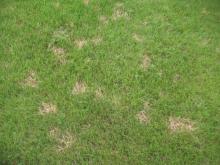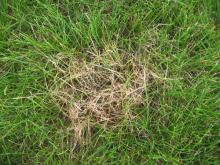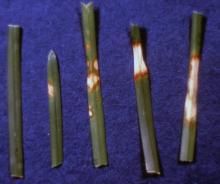Hosts Many cool-season species but a real problem on creeping bentgrass maintained at putting green or fairway height. This pathogen is also observed on annual bluegrass and perennial ryegrass, but to a much lesser extent.
Cause A fungus currently known as Clarireedia jacksonii on cool-season turfgrass and Clarireedia monteithiana on warm-season turfgrass in the USA. This fungus was previously known as Sclerotinia homoeocarpa. This fungus survives in the thatch and symptomless plants. Infection occurs through mycelial growth into the leaves (cut tips, stomata or directly) and crown. Nutrients in guttation fluid encourage successful fungal infection. It is suspected that mowers can spread the disease via leaf spread. Favorable conditions include prolonged leaf wetness and dry soil conditions coupled with warm days and cool nights. These are typical early fall conditions in the Pacific Northwest. Low nitrogen fertility is also a major factor in disease development. This disease is an infrequent or sporadic problem in the PNW where numerous patches may be seen during a favorable fall but not again for several more years. More prevalent on the east side of the Cascade Range where the dominant putting green turf is creeping bentgrass.
Symptoms Small, roughly circular, bleached patches develop in the turf. Spots are generally a few inches in diameter but can exceed 6 inches when conditions are favorable. Numerous spots may occur and coalesce into large, irregular dead areas. Leaves develop light yellow to tan lesions with reddish-brown borders or lines. Lesions occur near the middle of the leaf and extend completely across the leaf blade. Leaf tips may dieback, and severely affected plants, within dollar spot patches, will wilt and turn tan to brown.
Cultural control
- Fertilize with adequate nitrogen in a balanced nutritional program. Although high rates of nitrogen can result in lower disease severity, the rate needed may be impractical to apply and result in undesirable nontarget impacts.
- Avoid light, frequent waterings. Use enough water, based on local growing conditions. Water in morning so turf will dry before night.
- Daily rolling has been shown to substantially reduce dollar spot activity, particularly when coupled with an increased mowing height. Any daily early morning leaf wetness removal tactic using dew whips, rollers or mowing will help.
- Collect and remove plant debris.
- Use resistant cultivars.
Chemical control Focus on cultural control tactics first. Resistance to many fungicide groups has been reported from many areas of the country. Alternate or tank-mix fungicides from different groups that have different modes of action. Limit the use of any one group during crop production. Plant growth regulators have been used to enhance disease management when combined with fungicides. Type II PGRs, however, will encourage resistance development to FRAC 3 fungicides. It has also been reported that application of FRAC 7 fungicides, such as Emerald, also select for the resistance to FRAC 3 fungicides. Isolates resistance to thiophanate methyl (group 1) are more likely to be resistant to FRAC 2, 3, and 7 fungicides. Fungi resistant to multiple fungicides have been found but those resistant to 3 or more groups are found at a lower frequency. Fungicides containing boscalid (FRAC 7) were able to provide acceptable management of fungi resistant to multiple fungicide groups in the lab.
Several forecasting or weather-based models have been developed to either predict first disease occurrence (a degree day model) or risk of disease development. The Smith-Kerns Dollar Spot Prediction Model (https://tdl.wisc.edu/dollar-spot-model/) is currently the standard model for cool-season turfgrass.
Products available in home packaging:
- BioAdvanced Fungus Control for Lawns at 32 fl oz/over 5,000 sq ft. Group 3 fungicide. H
- Infuse Systemic Disease Control at 3 fl oz/1 gal water/250 sq ft of lawn. Group 3 fungicide. H
Products available for commercial use:
- Chipco 26019 FLO at 3 to 4 fl oz/1,000 sq ft. Group 2 fungicide. 12-hr reentry.
- Daconil Weather Stik at 2 to 5.5 fl oz/1,000 sq ft depending on whether the application is preventive or curative. Group M5 fungicide. 12-hr reentry.
- Densicor at 8.5 fl oz/A or 0.196 fl oz/1,000 sq ft. Do not use hand held equipment. Group 3 fungicide. Reenter when sprays have dried.
- Disarm 480 SC at 0.18 to 0.36 fl oz/1,000 sq ft plus another fungicide with a different mode of activity. Group 11 fungicide. 12-hr reentry.
- Eagle 20 EW at 1 to 2.4 fl oz/1,000 sq ft. May produce a growth regulation effect on Kentucky bluegrass. Group 3 fungicide. 24-hr reentry.
- Emerald at 0.13 to 0.18 oz/1,000 sq ft. Golf Course use only. Enter after sprays have dried. Group 7 fungicide.
- Fame SC at 0.2 to 0.4 fl oz/1,000 sq ft. Group 11 fungicide. 12-hr reentry.
- Floxcor at 0.18 to 0.36 fl oz/1,000 sq ft plus an adjuvant. Group 11 fungicide. 12-hr reentry.
- Mancozeb 80% (Fore, Manzate, and Protect DF) at 6 to 8 oz/1,000 sq ft. Group M3 fungicide. 24-hr reentry.
- Maxtima at 0.4 to 0.6 fl oz/1,000 sq ft. Group 3 fungicide. 12-hr reentry.
- Mirage at 1 to 2 fl oz/1,000 sq ft. Group 3 fungicide. 12-hr reentry.
- Monsoon Turf at 0.6 fl oz/1,000 sq ft. Group 3 fungicide. 12-hr reentry.
- Pinpoint at 0.275 to 0.31 fl oz/1,000 sq ft. Apply to dry turf or after mowing. Group 11 fungicide. 12-hr reentry.
- Posterity at 0.08 to 0.32 fl oz/1,000 sq ft. Group 7 fungicide. Reenter when sprays have dried.
- Previa at 2 to 5.5 fl oz/1,000 sq ft. Group M5 fungicide. 12-hr reentry.
- Propiconazole-based products. Group 3 fungicides.
- Banner MAXX at 0.5 to 2 fl oz/1,000 sq ft. 12-hr reentry.
- PropiMax EC at 0.18 to 0.73 fl oz/1,000 sq ft. 12-hr reentry.
- Rayora at 0.7 to 1.4 fl oz/1,000 sq ft. Group 3 fungicide. Reentry after sprays have dried.
- Secure at 0.5 fl oz/1,000 sq ft. Group 29 fungicide. Reentry when sprays have dried.
- Tebuzol 3.6F at 0.6 fl oz/1,000 sq ft. Group 3 fungicide. No reentry interval listed.
- Torque at 0.6 to 1.1 fl oz/1,000 sq ft. Do not mix with growth regulators during hot weather as injury may develop. Group 3 fungicide. 12-hr reentry.
- Tourney EZ at 0.18 to 0.37 oz/1,000 sq ft. Do not apply to Poa annua putting greens. Group 3 fungicide. 12-hr reentry.
- Trinity at 1 to 2 fl oz/1,000 sq ft. Do not mix with growth regulators during hot weather as injury may develop. Group 3 fungicide. 12-hr reentry.
- Velista at 0.3 to 0.5 oz/1,000 sq ft. Group 7 fungicide. 12-hr reentry.
- Xzemplar at 0.16 to 0.26 fl oz/1,000 sq ft. Group 7 fungicide. 12-hr reentry.
Combination Fungicides
- Armada 50 WDG at 0.6 to 1.5 oz/1,000 sq ft. Do not use a silicone-based surfactant. Group 3 + 11 fungicide. 12-hr reentry.
- Briskway at 0.5 to 1.2 fl oz/1,000 sq ft. Can be used in hot weather. Group 3 + 11 fungicide. Reentry when sprays have dried.
- Concert at 1.5 to 8.3 fl oz/1,000 sq ft. Do not use on fine fescue turf. Group 3 + M5 fungicide. 12-hr reentry.
- Encartis at 3 to 4 fl oz/1,000 sq ft. Do not use with oil-based pesticides. Group 7 + M5 fungicide. Reentry when sprays have dried.
- Exteris Stressgard at 1.5 to 4 fl oz/1,000 sq ft. Water in lightly after application. Group 7 + 11 fungicide. 12-hr reentry.
- Headway at 1.5 to 3 fl oz/1,000 sq ft. Do not use with silicone-based surfactants or EC formulations. Group 3 + 11 fungicide. 12-hr reentry.
- Honor at 0.83 to 1.1 oz/1,000 sq ft. Do not use with organosilicone-based adjuvants. Group 7 + 11 fungicide. Golf course turf only.
- Interface at 3 to 5 fl oz/1,000 sq ft or at 2 to 4 fl oz/1,000 sq ft on fairways. Maintain agitation while spraying. Do not mix with adjuvants. Group 2 + 11 fungicide. 24-hr reentry.
- Lexicon at 0.34 to 0.47 fl oz/1,000 sq ft. Group 7 + 11 fungicide. 12-hr reentry.
- Navicon at 0.7 to 0.85 fl oz/1,000 sq ft. Group 3 + 11 fungicide. 12-hr reentry.
- Pillar G at 3 lb/1,000 sq ft. Use a soil wetting agent prior to application. Group 3 + 11 fungicide. 12-hr reentry.
- Premion at 6 to 8 fl oz/1,000 sq ft. Group 3 +14 fungicide. Reentry when sprays have dried.
- Renown at 2.5 to 4.5 fl oz/1,000 sq ft. Group M5 + 11 fungicide. 12-hr reentry.
- Tartan at 1 to 2 fl oz/1,000 sq ft. Group 3 + 11 fungicide. 12-hr reentry.
Note: Some registered products offer only suppression of this disease and thus are not recommended for use. These products include Insignia and Heritage Action.
References Sapkota, S., Catching, K.E., Raymer, P.L., Martinez-Espinoza, A.D. and Bahri, B.A. 2022. New approaches to an old problem: Dollar spot of turfgrass. Phytopathology. 112:469-480.
Shi, X., Min, S. and Jung, G. 2024. Field Evaluation of Fluazinam Fungicide in Dollar Spot Populations Confirmed In Vitro Insensitivity. Plant Disease, 108:3329-3335.






